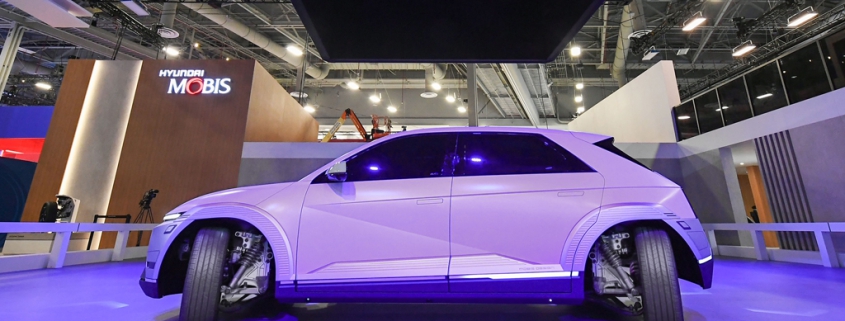Hyundai Mobis claims that we will soon be able to move around in a vehicle like a crab.
Would you like to drive your vehicle like a crab? Until now reserved for exceptional vehicles, such as the electric GMC Hummer, this mode of movement could soon become the hallmark of widely available vehicles. This is what Hyundai Mobis suggests with the Mobion system presented at CES 2024 in Las Vegas last week.
Mobion is the name of a new generation of Hyundai Mobis’ “e-Corner” system, the supplier of the Hyundai Group. Designed for electric vehicles (EVs), this full-wheel steering system allows all four wheels to rotate 90 degrees to perform parallel, lateral, and even oblique movements, like a crab walking on sand.
This new version of e-Corner also allows for 180-degree turns and even “zero turn,” where the front wheels turn inward and the rear wheels turn outward to perform a 360-degree turn at idle. This function would allow the driver, for example, to change direction in a narrow space using very little space.
Hyundai Mobis uses the term “motion technology” to describe Mobion, combining the name “Mobis” with the English term “on” (in motion).
This system allows a vehicle to move in all these ways because all four wheels are controlled individually. The e-Corner system, responsible for translating these dynamic movements into reality, uses four key technologies, starting with four in-wheel motors used to propel the vehicle. Hyundai Mobis calls this the “In-wheel” system.
“The In-wheel technology consists of placing four small motors inside each wheel, as opposed to the single drive motor commonly used in electric vehicles,” explains Vice President Lee Young-Kook, head of Hyundai Mobis’ electrification laboratory. “This configuration allows each wheel to generate its own energy independently.” With this system, each in-wheel motor seamlessly integrates braking, steering, and suspension functions.
The Mobion system also stands out for its sensor and lamp systems used for autonomous driving. Three LiDAR devices, which use light for detection and distance estimation, serve as sensors for autonomous driving maneuvers. Two short-range LiDARs are placed near the left and right headlights, while a third, long-range LiDAR is installed in the center of the vehicle at the front. The supplier claims that this configuration is “particularly useful for lateral movements and effective recognition of nearby objects, especially during maneuvers such as diagonal lane changes.”
In addition to that, there is an “exterior lighting indicator” and other display functions. For example, an LED fixed to the front bumper transmits information to a short-range LiDAR to detect pedestrians. Thus, when the vehicle is at an intersection, the LED can indicate, for example, the direction in which a pedestrian is crossing the street. A detection system integrated into the rear bumper also informs the driver of the presence of pedestrians.
At CES, Mobis also presented a new ground projection function. Integrated into the e-Corner system, this 360-degree ground arrow projection informs people around the vehicle of the driver’s direction. When pedestrians are detected nearby, Mobion can even project strips of light on the ground representing a safe pedestrian crossing!
“Together, Mobis has created Mobion to showcase our products and key capabilities,” said Vice President Lee Seung-Hwan, head of advanced engineering at Hyundai Mobis.
To illustrate the possibilities of this system to the CES audience, Hyundai Mobis had a large demonstration track in its booth, where a Hyundai Ioniq 5 prototype equipped with the Mobion system performed an elegant automotive ballet to the delight of the onlookers.
The supplier also produced the video featuring New Zealand hip-hop dancer Kirsten Dodgen from ReQuest, demonstrating the various maneuvers made possible by the Mobion system, such as the “zero turn,” sideways movement, pivot turns, and diagonal movement.
Photo: Hyundai Mobis



